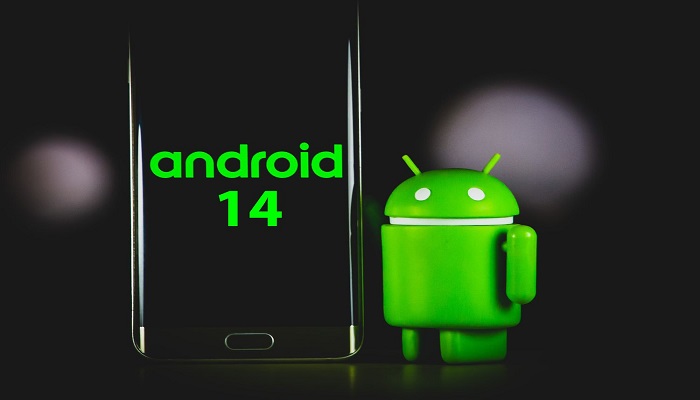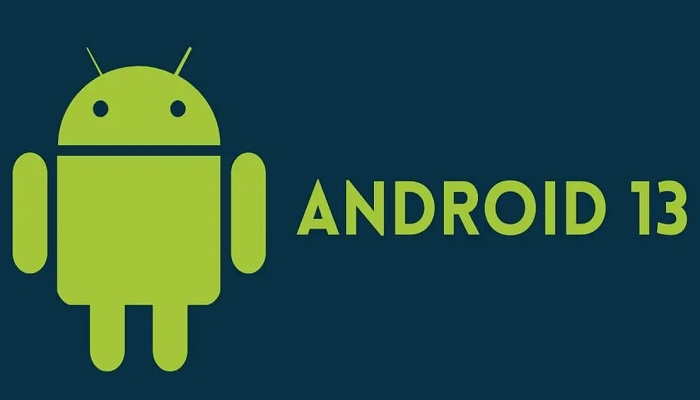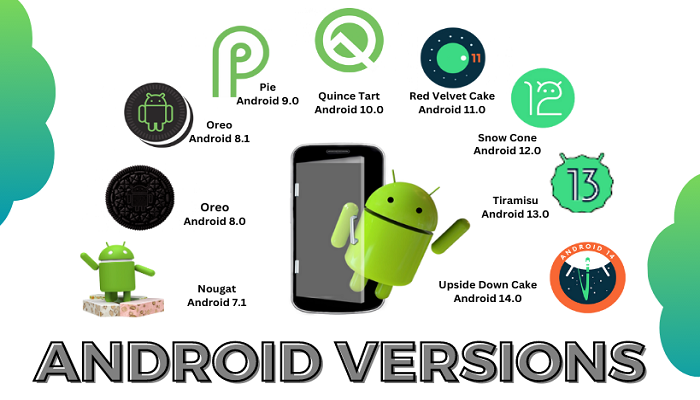After Reading This Article, You Will Know The Name of All Android Versions, Release Date, and Symbol.
Do you prefer the Android operating system? If yes, then you must read this.
Virtually 90% of smartphone users use Android OS. Hence, this post contains a list of all Android Models (Previous, latest, and Modern).
As you may know, the Android OS is a Linux-based operating system designed for smartphones and tablets which was launched on 5 Nov. 2007 with Android Beta Model. It was developed by Google and the Open Handset Alliance (OHA).
The first Business version of Android 1.0 was launched on 23 Sep – 2008.
In this post, you will learn all the released versions of the Android Operating System and be able to identify them with pictures.
List of All Android Versions And Details
Android 14 (Upside Down Cake)

Android 14 beta version was released on April 12, 2023, while the latest release was on July 2, 2024.
Key Features of Android 14
- Customization: Android 14 offers new customization options, including unique, AI-generated wallpapers, a new customization picker for easier personalization of lock and home screens, and custom clocks and lock screen shortcuts on Pixel devices.
- Camera and Media: Android 14 introduces Ultra HDR for high dynamic range photos, more camera extensions, and lossless USB audio for richer camera and media experiences.
- Accessibility: Android 14 expands accessibility features, including increased font size up to 200%, nonlinear font scaling, and expanded multilingual support.
- Privacy and Security: Android 14 enhances privacy and security with features like photo picker, Health Connect, and blocked installation of apps targeting versions below Marshmallow (6.0).
- User Experience: Android 14 offers an improved user experience with a new Grammatical Inflection API, an expanded taskbar on larger screens, and the ability to use a phone as a webcam.
Android 13 (Tiramisu)

Android 13 is the latest version of the Android operating system, released on August 15, 2022.
Key Features of Android 13
Here are some of its key features and updates:
- Customizable Apps: Users can customize their apps by color, theme, and language.
- Security Controls: Android 13 has advanced security controls, including a new media picker that allows users to choose which photos and video apps have access to.
- Notification Permissions: Apps are now required to request permission from the user before sending notifications.
- Bluetooth LE Audio: Android 13 supports Bluetooth LE Audio, which enables receiving and sharing audio between multiple Bluetooth devices simultaneously.
- WiFi 7: Android 13 supports WiFi 7, which decreases latency, buffering, lag, and congestion.
- Per-App Language Preferences: Users can change the language for a specific app, rather than doing so for the entire software.
- Themed App Icons: Android 13 allows users to theme their app icons.
- Split Screen Mode: Split Screen mode now persists through app changes, making it possible to use other apps and the phone launcher while still using split-screen apps.
- Garbage Collector: Android 13 ART was updated with a new garbage collector, which reduces memory pressure, compiled code size, and jank.
Android 12 (Snow Cone)
Android 12 is the latest Android version and the best among the rest list of the Android versions. Android 12 was released on the 4th of October 2021.
This Android version is the 12th major release led by Google which features dynamic color capabilities that can transform your user’s experience, especially based on the responsive motion that responds to the touch and wallpaper.
The widgets on this version of Android have been given a facelift, with your favorite people always available right there on your phone home screen.
Android 12 remodifies the entire UI, from its shapes, motion, and light. It comes with a smart customizable system of colors that can easily adapt to match.
New Features In Android 12
- Scrolling screenshots: screenshots have been in existence for a long time. But the screenshot enhancement in the Android 12 version is superb. You can take a screenshot as normal, but you can also click on the Capture More button to get a full-scrolling screenshot, which allows you to crop from there if you choose to. Additionally, the screenshot edit section has been improved generally with new features like adding text and other fancy things.
- App Search: This feature is new to Android, it basically allows Android users to search for stuff within apps, just as we see it on the Windows operating system. For example, searching for something you wrote in a note and the search will direct you to that note without entering the app. The most amazing about the App search is that it works offline.
- Improved auto-rotate: The improved auto-rotate now helps detect when your android mobile phone is flipped on its side and then the screen does the same by itself. It also supports face detection for auto-rotate, Android’s previous versions don’t support face detection for auto-rotate. This is a big enhancement for android users.
- Easier Wi-Fi sharing: The android version 12 now has a small button that allows you to use Nearby Share to send your Wi-Fi credentials to another person’s phone. It’s now super fast when sharing with multiple people. It doesn’t require you to hold your android 12 mobile phone up for everyone to scan.
- One-handed mode: Android 12 comes with a native one-handed mode. You will find this feature in the Settings >> System >> Gestures. This mode will shrink everything down to half size, just like when you are in the multi-window mode.
- Rich content insertion: This feature is best for developers who let their apps move media between apps. With this, you will be able to do something like copy and paste an image from one application to another. The major advantage is that it would help cut out the middleman in sharing images.
- Audio selection in the media player: The Android 12 added the media player present in the Quick Settings, it lets one easily change their audio source by clicking on the button and a list will appear showing all the currently connected devices. For example, you will be able to switch from your phone speaker to your Bluetooth speaker at the press of a button.
Android 11 (Red Velvet Cake)
On the 8th of September 2020, Android announced, more on the Android 11 will be updated here shortly. The Android 11 is believed to have the most amazing upgrade among other Android versions.
Features of Android 11
- Conversations: It gives users the room to collect all their messages in one place.
- Accessibility: Perceptive applications help to navigate and control our device with a voice command.
- Security and Privacy: improved security and privacy fix to our smartphone from Google Play.
- Media: We can now play music from other devices that are connected to our phones.
- Device controls: Android 11 version OS allows easy control of all our connected devices (IoT) at a single point.
- Content capture: This operating system comes with default screen recording features, third-party app is no longer required.
- Predictive tools: By predicting our patterns of working, as well as our habits, it suggests accordingly.
Android 10 (Quince Tart)
Android version 10 was officially released in September 2019. The Android 11 operating system known as the Android Q has been in beta for a while but now it is rolling out first to Google’s own line of Pixel phones, then to others.
Features of Android 10
- Dark theme option available
- Focus mode to help users focus without distraction
- Smart Reply in all messaging apps
- It is compatible with the 5G network
- Enhanced location and privacy tools
- New parental controls offer parents a way to monitor and regulate their kids’ screen
- Incognito mode for Google Maps to gain a private-search mode
- Live Caption
- Sending updates straight to your phone
- Edge-to-edge gestures to swipe up from the bottom of your home screen, from left to right to go back.
- Fit for foldable phones like the Galaxy Fold and Huawei Mate X.
Android 9 (Android Pie)
Google Officially released Android Pie 9.0 on 6 Aug 2018 and named it Android Pie. On Android 9, Google built-in many improvements when compared to the older 8.0 and 8.1 Oreo versions.
Features of Android 9 (Android Pie)
- Enhanced user interface for the quick settings menu
- A new transition for switching between apps and activities within apps.
- A new Lockdown mode that disables biometric authentication once activated, will be disabled once the user used their password to login
- Much richer message notifications, where a full conversation can be had within a notification, full-scale images, and smart replies.
- Battery percentage now is shown On Display.
- Better multitask app switcher with Google search bar and app drawer built-in.
- A new gesture-based system interface, like seen on the iPhone X.
- A Shush Gesture feature.
- An adaptive battery feature that maximizes battery power by prioritizing the apps you are most likely to use next.
- It includes controller mapping for the Xbox One S wireless controller.
- Includes back button icon in the navigation bar if the gesture navigation is enabled.
- The volume slider is now located next to the device’s physical volume button.
- HEIF support.
Android 8.0, 8.1 (Oreo)
Android 8.0 was officially released in August 2017 under the name “Oreo” a few months after, in December 2017 Android 8.1 was released which features minor bug fixes.
Features of Android 8.0, 8.1
- Notification grouping,
- Performance improvements,
- Battery usage optimization,
- Picture-in-picture support for video,
- Support for auto fillers,
- Bluetooth 5,
- Wide color gamuts,
- Wi-Fi Aware
- System-level integration with VoIP apps.
- Android Go – a software distribution of the operating system mainly for the low-end devices – as well as support for the implementation of a hardware abstraction layer.
Android 7.0 (Nougat)
The Android version 7.0 Nougat is among the best seller versions of Android, which was launched in August 2016. This Android version has improved performance and better battery management, among many other features its native multi-windowed support improved to facilitate multitasking.
Features of Android 7.0 Nougat
- Ability to display multiple applications on-screen at once in a split-screen view,
- Support for in-line replies to all notifications,
- Expanded “Doze” energy-saving mode which restricts the device from functioning once the screen has been off for a while,
- OpenJDK-based Java environment and received support for the Vulkan graphics rendering API,
- System updates on supported devices.
Android 6.0 (Marshmallow)
The Android 6.0 Marshmallow was launched on May 28, 2015. Its is so slick and has some fantastic features which will be built the taste of most smartphone users.
Features of Android 6.0
- Permissions architecture.
- New APIs for contextual assistants to provide context-sensitive search results.
- A power management system that will reduce background activity when a device is not handled physically.
- Native support for fingerprint recognition and USB type C connection.
- Ability to migrate your applications and data to a microSD card.
- Lots of internal changes.
Android 5.0/5.1 (Lollipop)
The Android 5.0 Lollipop was launched on Nov 12, 2014. Similar to the Kitkat, the Lollipop is so amazing in its way.
Features of Android 5.0/5.1
- A redesigned user interface is built around a design language called Material Design.
- Improvements to the notifications, which can be accessed from the lock screen and displayed within applications as “top of the screen” banners.
- Internal changes with the Android Runtime (ART) officially replacing Dalvik for improved application performance.
- Improve and optimize battery usage.
Android 4.4 (KitKat)
Android 4.4 KitKat, which was announced on the Third of Sept, 2013 by Google. Android 4.4 is optimized to run on an enormous range of smartphones the oldest Android Model, Having 512 MB RAM
Features of Android 4.4 KitKat
- Improved Android’s performance on low-end hardware.
- Google Hangout which replaced the messaging app
- Translucent System UI
- Introduction of Host Card Emulation support for secured transactions
- Google Drive is now a default app in KitKat.
- Better performance and useful appearance improvements.
Android 4.1/4.2/ 4.3 (Jelly Bean)
At the Google, I/O conference by Google, which was held on June 27, 2012, Android 4.1 code-named Jelly Bean was released.
It was primarily based on Linux kernel 3.0.31. Android 4.1, 4.2, 4.3 Jelly Bean was launched to the Android Open Source on July 9, 2012. The first Android Jelly Bean gadget is the Nexus 7 tablet, released on July 13, 2012.
Android 4.0 (Cream Sandwich)
Android version 4.0 Ice Cream Sandwich was launched on Oct 19, 2011, and was based mostly on Linux kernel 3.0.1.
Android 3.0 / 3.2 (Honeycomb)
Android 3.0, also known as Honeycomb, was released on Feb 22, 2011. It was based mostly on Linux kernel 2.6.36. The first device utilizing this version was the Motorola Xoom tablet, which was launched on 24 Feb 2011.
Android 2.3 / 2.3.7 (GingerBread)
Android 2.3 code-named Gingerbread was launched on Dec 6, 2010. The OS was based on Linux kernel 2.6.35
Android 2.2 (Froyo)
Android 2.2 code-named Froyo was launched on May 20, 2010. The Android OS was based on Linux kernel 2.6.32
Android 2.0 (Eclair)
On Oct 26, 2009, Android 2.0, also called Eclair and Which was also based on Linux kernel 2.6.29, was released.
Android 1.6 (Donut)
On Sep 15, 2009, Android 1.6, also called Donut, was launched. It was based entirely on Linux kernel 2.6.29.
Android 1.5 (Cupcake)
Android 1.5 also called Cupcake was launched on 30 April 2009 Which was completely based mostly on Linux kernel 2.6.27. Android 1.5 was the very first official launch using a code name primarily based on a type of “dessert” known as Cupcake.
Android 1.1
On the 9th of February 2009, the Android 1.1 Version was launched.
RELATED ARTICLES
- List of All Apple Products and Services
- 8 Ways To Save Your Android Battery Life Forever
- How To Block Private and Non Private Callers Without Any App
- What Causes The Changes In Bitcoin Price?
Related tags: latest android version | android version 10 | android version history| android version 11 | best android version | list of android versions | android release date | android 12 release date.


